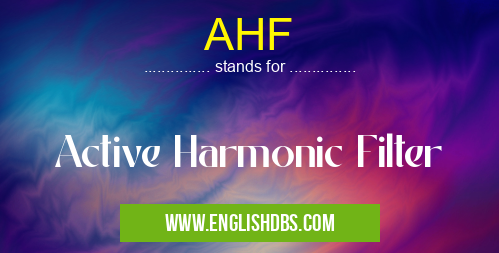What does AHF mean in UNCLASSIFIED
AHF (Active Harmonic Filter) is an electrical device used to reduce harmonic distortion and improve power quality in electrical systems. Harmonic distortion refers to the presence of unwanted harmonic frequencies in an electrical waveform, which can cause interference and equipment damage.

AHF meaning in Unclassified in Miscellaneous
AHF mostly used in an acronym Unclassified in Category Miscellaneous that means Active Harmonic Filter
Shorthand: AHF,
Full Form: Active Harmonic Filter
For more information of "Active Harmonic Filter", see the section below.
How AHF Works
AHF operates by generating harmonic currents that are equal in magnitude but opposite in phase to the harmonic currents present in the system. By injecting these opposing currents, the AHF effectively cancels out the harmonic distortion, resulting in a cleaner and more sinusoidal waveform.
Benefits of AHF
- Improved Power Quality: AHF reduces harmonic distortion, enhancing the quality of electrical power and ensuring reliable operation of equipment.
- Increased Equipment Lifespan: Reducing harmonic distortion minimizes stress on electrical equipment, extending its service life.
- Compliance with Standards: AHF helps utilities and industrial facilities comply with power quality standards, such as IEEE 519 and EN 61000-3-4.
- Energy Savings: By improving power factor and reducing losses due to harmonic distortion, AHF can contribute to energy savings.
Types of AHF
- Passive AHF: Consists of passive components, such as capacitors and inductors, to filter out harmonics.
- Active AHF: Uses power electronics to generate and inject harmonic currents to cancel out distortion.
- Hybrid AHF: Combines passive and active components for optimal performance.
Essential Questions and Answers on Active Harmonic Filter in "MISCELLANEOUS»UNFILED"
What is an Active Harmonic Filter (AHF)?
An Active Harmonic Filter (AHF) is a device used to reduce the harmonic distortion caused by non-linear loads in electrical power systems. It injects an equal and opposite harmonic current to cancel out the harmonic currents generated by these loads, resulting in a cleaner and more efficient power supply.
How does an AHF work?
An AHF consists of a power converter, a control system, and a harmonic filter. The power converter generates a current that is equal and opposite to the harmonic currents produced by the non-linear loads. The control system monitors the harmonic distortion and adjusts the output of the power converter accordingly. The harmonic filter then removes the harmonic currents from the power supply.
What are the benefits of using an AHF?
Benefits of using an AHF include:
- Reduced harmonic distortion
- Improved power quality
- Increased efficiency of electrical equipment
- Reduced electromagnetic interference
- Extended lifespan of electrical equipment
Where are AHFs typically used?
AHFs are commonly used in industrial and commercial applications where there are a large number of non-linear loads, such as variable frequency drives, uninterruptible power supplies, and arc furnaces. They can also be used in residential applications with high levels of harmonic distortion.
How do I choose the right AHF for my application?
The selection of an appropriate AHF depends on several factors, including the load characteristics, the desired level of harmonic reduction, and the available budget. It is recommended to consult with an electrical engineer or AHF manufacturer for assistance in selecting the optimal AHF for your specific needs.
Final Words: AHF is a valuable solution for improving power quality and reducing harmonic distortion in electrical systems. By injecting opposing harmonic currents, AHF effectively cancels out distortion, resulting in a cleaner waveform, improved equipment reliability, and increased energy efficiency.
AHF also stands for: |
|
| All stands for AHF |
